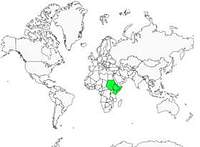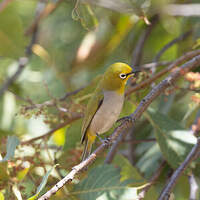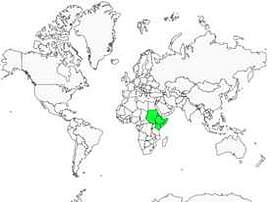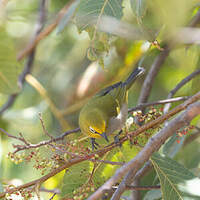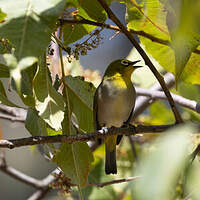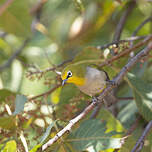Ethiopian White-eye
Zosterops poliogastrus - Zostérops alticole
Identification
With its features, yellow plumage and white-ringed eye, Heuglin's White-eye is instantly recognizable to the genus Zosterops. There is no sexual dimorphism in Heuglin's white-eye and the immature looks like the adult. The nominate subspecies of adult Heuglin's White-eye have a bright yellow forehead, chin and throat. The rest of the head, upperparts, wing coverts and rump fringes are olive-green, tinged with yellow. The brown eyes are surrounded by a white ocular ring, 1 to 2 mm wide. The black lores extend as a half-moon below the eyes. The thin and pointed beak is black, slightly bluish at the base. The underparts vary according to subspecies. The upperparts and sides of the chest are light grey. The flanks have a grey tinge of tawny. The belly is white, sometimes tinged with yellow. The undertail coverts are yellow. The legs are slate-grey.
The subspecies differ in the colour of the upper parts, from yellow-green to more intense green, and in the colour of the lower parts. In kaffensis subspecies, the middle of the body is yellow from the chest to the undertail coverts, while the sides of the chest and flanks are dark green. In kulalensis, there is a strong contrast between dark grey flanks and sides and a pale mid-ventral band, tinged with yellow. The perception of colours of the upper parts is often distorted by ambient light, making this criterion less useful.
Subspecific information monotypic species
Foreign names
- Zostérops alticole,
- Anteojitos serrano etíope,
- olho-branco-etíope,
- Bergbrillenvogel,
- abesszin pápaszemesmadár,
- Heuglins Brilvogel,
- Occhialino quattrocchi,
- heuglinglasögonfågel,
- Bergbrillefugl,
- okánik ozdobný,
- kruhoočko východoafrické,
- Bredringet Brillefugl,
- etiopianrilli,
- zostèrops afroalpí,
- szlarnik białooki,
- Желтобрюхая белоглазка,
- アフリカヤマメジロ,
- 宽翼绣眼鸟,
- etiopienglasögonfågel,
- 寛眶繡眼,
Voice song and call
The song is a series of fluted notes, modulated and quite long, a bit melancholic, with a timbre that is surprising for such a small bird. There are regional variations. Heuglin's White-eye warbles when it is in a group. We can thus not talk about a song. When looking for food, the birds express themselves with varied clear cries formed of 2 to 5 notes. The contact cries between individuals are typical of the species, brief and shrill.
Habitat
Heuglin's White-eye is a high-altitude bird as its name suggests. It is mainly found above 1 500 m. It occupies wooded formations, dense or degraded forests, but also lower woody vegetation and their ecotones, occasionally plantations and peri-urban areas.
Behaviour character trait
Heuglin's White-eye is a gregarious and non-territorial species. Groups of up to 30 birds, and up to 50 in the kulalensis subspecies, are most commonly seen during the dry season.
It is most active at dawn and dusk, particularly in the search for food. Individuals interact with each other and keep in contact through their voices. Generally sedentary, it may travel to find food if necessary away from its usual areas. The other movements are governed by the seasons, with a dry mountainous habitat temporarily abandoned for a more humid one. In spite of these movements, no mixing of populations, even those that are geographically close (less than 100 km) has ever been observed.Dietfeeding habits
During the dry season, Heuglin's White-eye is primarily a frugivore. It also becomes an insectivore during the wet season. Its menu consists of fruits (small berries, pulp of larger fruits like figs), nectar, and invertebrates such as aphids, small spiders, and caterpillars. It is very active, jumping from branch to branch, inspecting the leaves, and visiting flowers.
Reproduction nesting
There is no breeding season as such for Heuglin's White-eye. Breeding is continuous throughout the year according to geographic range.
In Sudan, nesting occurs from November to April, in Ethiopia from April to December, and from February to June in East Africa. Since this species is gregarious and not territorial, couples may nest near each other. The nest is built by both sexes in 7-10 days and forms a small cup of 4-5 cm in diameter and 3-5 cm in depth, suspended between two branches or in a fork protected by vegetation cover that will insulate it from the sun and rain. It is made of lichens, moss, plant fibers and spider webs. Sometimes green moss is placed on the outside of the cup. The female lays 2 or 3 white or blue eggs. Both sexes incubate. There is currently no known tracking that would give information about the incubation period or the course of nesting.Geographic range
Threats - protection
IUCN conservation status
concern
in the Wild
threatened
evaluated
Heuglin's White-eye is generally not threatened. The subspecies kulalensis, which is restricted to Mount Kulal only, is therefore considered vulnerable, especially since the forest is subject to increasing human pressure. The more widely distributed populations are also affected by negative human practices, such as deforestation for agriculture and extensive grazing, which reduce the capacity of the forests.
Sources of information
- IOC World Bird List (v15.1), Gill, F and D Donsker (Eds). 2025-12-07.
- Avibase, Lepage Denis
- HBW Alive,
- Birds of the Horn of Africa, Nigel Redman
- Birds of Kenya and Northern Tanzania, Dale A Zimmerman, Donald A Turner, David J Pearson
Other sources of interest
 Specification sheet created on
21/07/2023 by Nathalie Santa Maria
Specification sheet created on
21/07/2023 by Nathalie Santa MariaTranslation by AI Oiseaux.net
© 1996-2025 Oiseaux.net
- Accipitriformes
- Aegotheliformes
- Anseriformes
- Apodiformes
- Apterygiformes
- Bucerotiformes
- Caprimulgiformes
- Cariamiformes
- Casuariiformes
- Charadriiformes
- Ciconiiformes
- Coliiformes
- Columbiformes
- Coraciiformes
- Cuculiformes
- Eurypygiformes
- Falconiformes
- Galliformes
- Gaviiformes
- Gruiformes
- Leptosomiformes
- Mesitornithiformes
- Musophagiformes
- Nyctibiiformes
- Opisthocomiformes
- Otidiformes
- Passeriformes
- Pelecaniformes
- Phaethontiformes
- Phoenicopteriformes
- Piciformes
- Podargiformes
- Podicipediformes
- Procellariiformes
- Psittaciformes
- Pterocliformes
- Rheiformes
- Sphenisciformes
- Steatornithiformes
- Strigiformes
- Struthioniformes
- Suliformes
- Tinamiformes
- Trogoniformes


